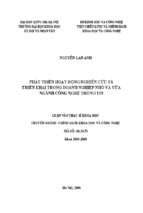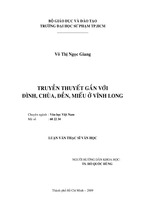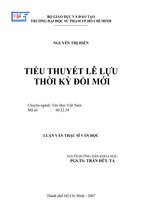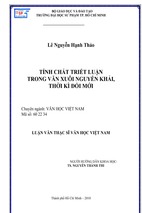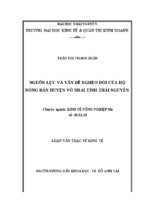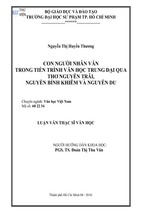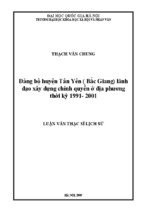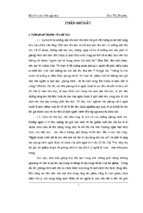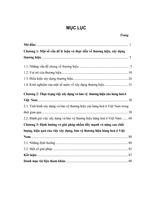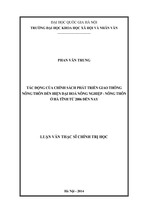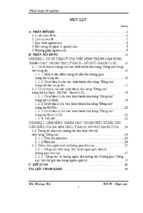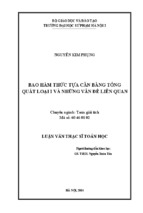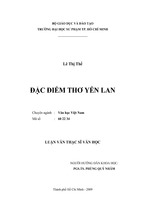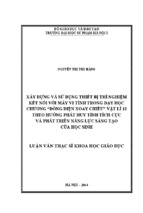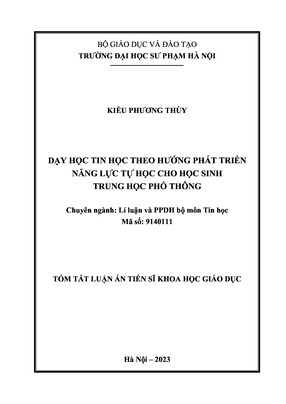VIETNAM NATIONAL UNIVERSITY, HA NOI
UNIVERSITY OF LANGUAGES AND INTERNATIONAL STUDIES
FALCUTY OF POST-GRADUATE STUDIES
BÙI THANH HUỆ
A VIETNAMESE- AUSTRALIAN INTERCULTURAL
STUDY ON HAPTICS IN COMMUNICATION
NGHIÊN CỨU LIÊN VĂN HÓA VIỆT-ÚC VỀ CÁC HÀNH VI ĐỘNG
CHẠM TRONG GIAO TIẾP
M.A. MINOR THESIS
Field:
Code:
ENGLISH LINGUISTICS
60.22.02.01
Hanoi-2013
VIETNAM NATIONAL UNIVERSITY, HA NOI
UNIVERSITY OF LANGUAGES AND INTERNATIONAL STUDIES
FALCUTY OF POST-GRADUATE STUDIES
BÙI THANH HUỆ
A VIETNAMESE- AUSTRALIAN INTERCULTURAL
STUDY ON HAPTICS IN COMMUNICATION
NGHIÊN CỨU LIÊN VĂN HÓA VIỆT-ÚC VỀ CÁC HÀNH VI ĐỘNG
CHẠM TRONG GIAO TIẾP
M.A. MINOR THESIS
Field:
ENGLISH LINGUISTICS
Code:
60.22.02.01
Supervisor:
Dr. Huỳnh Anh Tuấn
Hanoi-2013
DECLARATION
This thesis is a presentation of my original research work. Wherever
contributions of others are involved, every effort is made to indicate this clearly,
with due reference to the literature, and acknowledgement of collaborative research
and discussions. The work was done under the guidance of Dr. Huynh Anh Tuan.
The research was approved by the University of Languages and International
Studies, Vietnam National University, Hanoi.
Hanoi, October 18th, 2013
Bui Thanh Hue
i
ACKNOWLEDGEMENTS
I would like to express my gratitude to all those who gave me the possibility
to make my thesis reach an end.
I would like to express my faithful gratitude to my supervisor, Dr. Huynh
Anh Tuan for his patient guidance, stimulating suggestions and encouragement
throughout my research.
I wish to thank all the staff members of the Faculty of Post Graduate Studies,
University of Languages and International Studies, VNU for providing me the best
environment to fulfill my thesis.
Especially, my sincere thanks send to my friend Vu Thi Kim Huong, Vice
Director of Atlantic Company and Nguyen Thi Thu Ha, an oversea student in
Australia for their helping me to contact Australian informants.
I am greatly indebted to my friends for their assistance of collecting data and
conducting interview without which this study could not have been successful.
Last but not least, I would like to express my special thanks to my family
who offered me their love, care, support and encouragement so that I could
accomplish my study.
Hanoi, October 2013
ii
ABSTRACT
This study aims to investigate haptics in communication of Vietnamese and
Australian people, examine the cultural values of the Vietnamese and the Australian
that influence norms of haptics in communication, and make comparison and
contrast of touching behavior between the two cultures. It also raises an awareness
of cultural differences in intercultural communication and gives some suggestions
to lessen the possibility of haptics miscommunication.
The data collection tools used in this study included observations and
interviews. Then contrastive analysis was carried out to clarify both similarities and
differences in haptics between the two cultures: Vietnamese and Australian.
The major findings of the study showed that both Vietnamese and Australian
people share some similar perceptions of haptics in communication. For example,
they feel quite free to practice some touching behavior with their relatives and close
friends like holding hands, linking/locking arms, hugging shoulder, hugging waist,
etc., or only hand-shaking with someone they do not know much of or meet at the
first time; and they feel more pleasant to touch or get touched by others of the same
sex more than those of the opposite sex. Besides, the study also denoted some
differences in touching norms between the Vietnamese and the Australian cultures.
Australian people seem to be more comfortable to touch each other in
communication, and not to pay much attention to sex distinction when touching
their relatives or close friends. On the other hand, Vietnamese people‟s touching
behavior tends to be influenced by sex distinction. They touch their relatives or
friends of the same sex more freely than they touch those of the opposite sex. Based
on the findings of the study, some discussions and implications were made along
with recommended suggestions for further research.
iii
TABLE OF CONTENTS
DECLARATION ........................................................................................................ i
ACKNOWLEDGEMENTS ......................................................................................ii
ABSTRACT. ............................................................................................................ iii
PART A. INTRODUCTION .................................................................................... 1
1. Rationale…… ....................................................................................................... 1
2. Aim and objectives of the study .......................................................................... 2
3. Scope of the study ................................................................................................. 2
4. Research questions ............................................................................................... 3
5. Methods of the study ............................................................................................ 3
6. Structure of the study .......................................................................................... 3
PART B. DEVELOPMENT ..................................................................................... 5
CHAPTER 1. LITERATURE REVIEW
.......................................................... 5
1.1. THEORETICAL BACKGROUND.................................................................. 5
1.1.1. Cross-cultural Communication vs. Intercultural Communication………5
1.1.1.1. Definitions of communication ..................................................................... 5
1.1.1.2. Cross-cultural Communication vs. Intercultural Communication ......... 5
1.1.2.Nonverbal communication .............................................................................. 6
1.1.2.1.Definitions of nonverbal communication .................................................... 6
1.1.2.2.Classification of nonverbal behavior ........................................................... 8
1.1.2.3.Functions of nonverbal behavior ................................................................. 9
1.1.2.4.The importance of nonverbal behavior ..................................................... 10
1.1.3.Haptics in communication ............................................................................. 11
1.1.3.1.Definitions of Haptics .................................................................................. 12
1.1.3.2.Classification of Haptics ............................................................................. 12
1.1.3.3.The role of Haptics in communication ...................................................... 14
iv
1.1.3.4.Haptics culture: high-contact, low-contact, and medium-contactb
cultures ..................................................................................................................... 17
1.2. PREVIOUS STUDIES ..................................................................................... 19
CHAPTER 2. RESEARCH METHODOLOGY .................................................. 21
2.1. An overview of survey approach .................................................................... 21
2.2. Research method .............................................................................................. 21
2.3. Data collection method .................................................................................... 22
2.4. Data analysis method ....................................................................................... 23
CHAPTER 3. RESULT AND DISCUSSION ....................................................... 24
3.1.he findings from observation ........................................................................... 24
3.1.1. Touching behavior of the Vietnamese and the Australian ........................ 24
3.1.2. Touching behavior in communication between the Vietnamese and the
Australian................................................................................................................ 29
3.1.3. Major similarities and differences in haptics between the Vietnamese and
the Australian .......................................................................................................... 31
3.2.The findings from interview ............................................................................. 32
3.2.1. The findings from interviews with the Vietnamese ................................... 33
3.2.2. The findings from interviews with the Australian ..................................... 34
3.2.3. Major similarities and differences in the Vietnamese and the
Australian’s perception of haptics in communication ......................................... 36
3.3.Discussion on the findings ................................................................................ 37
3.3.1. Cultural values of the Vietnamese influence their norms of haptics in
communication ....................................................................................................... 37
3.3.2. Cultural values of the Australian influence their norms of haptics in
communication ....................................................................................................... 38
PART C. CONCLUSION ....................................................................................... 41
v
1.Summary ............................................................................................................... 41
2.Suggestions for more effective intercultural communication .......................... 42
3.Limitations of the study and suggestions for further study ............................. 43
REFERENCES ........................................................................................................ 44
APPENDIX ............................................................................................................... I
vi
PART A: INTRODUCTION
1. Rationale
“We should never denigrate any other culture but rather help people to
understand the relationship between their own culture and the dominant
culture. When you understand another culture or language, it does not mean
that you have to lose your own culture. ”
Edward T. Hall
In the wake of globalization, people of different nations nowadays become
closer and closer. The academic study of intercultural communication focuses on
the interactions between people from different cultures. Misunderstandings and
conflicts happen in various aspects of intercultural communication such as linguistic
differences, diverging stereotypes, social roles and belief systems. The intercultural
studies assume the responsibility of facilitating resolution to intercultural
communication problems. In fact, people often not only interact with each other by
words but also a range of touching behavior to express their intents. The
combination of verbal and nonverbal language in communication sometimes creates
culture shock and communication breakdown because every culture has its own
norms and customs and has a different way of communicating with its members.
Haptics-touching behavior is considered to play an important role in communication
because it can replace words to express speakers‟ feelings, greetings and opinions
and reduce cognitive burden for speakers. Moreover, haptics can help listeners
facilitate comprehension of a spoken message as well as convey thoughts not
presented in speech. However, Toomey (1998) emphasized that different cultures
have different expectations as to who should touch whom in different interaction
scenes. It is due that touching behavior is habitual and routine, thus people tend to
use it unconsciously and spontaneously. The meaning of each touch depends upon
the individuals involved, the context in which the act is performed, and the cultural
backgrounds of the interacting people. Understanding your own culture as well as
1
the others‟ is very important for everybody to find it easier to communicate
effectively and know the reason why people act in the different ways and avoid
unnecessary miscommunication. According to Toomey (1998), the Vietnamese is a
member of low-contact cultures and the Australian is a member of moderate-contact
cultures, so when people from these two cultures interact with each other,
miscommunication always runs the risk of breaking out. In this study, the touching
behavior of the Vietnamese and the Australian will be observed to explore the
comparison and contrast in norms of haptics influenced by different cultural values
between the Vietnamese and the Australian cultures. It is expected to raise an
awareness of cultural differences when interacting across cultures, and then give
some suggestions to lessen the possibility of haptics miscommunication.
2. Aim and objectives of the study
This study is carried out with the aim of making comparison and contrast
between the Vietnamese and the Australian cultures of haptics, so it is expected to
fulfill the following specific objectives:
Investigating the similarities and differences of haptics in communication
between Vietnamese and Australian people
Raising an awareness of cultural differences when interacting across cultures
Making contribution to avoiding intercultural problems of haptics in
communication by giving some suggestions
3. Scope of the study
This study discusses the topic of nonverbal communication. Extralinguistically, the study especially emphasizes on haptics communication in the two
cultures: Vietnamese and Australian.
2
4. Research questions
To satisfy the purpose of the study, two research questions, which are
suitable and applicable of viewing the norms of haptics in communication between
the Vietnamese and the Australian under the cultural perception, are raised.
Therefore, it is expected to seek answers to the following questions:
1. How do Vietnamese and Australian people practice their haptics in
communication?
2. What cultural values influence the norms of touching behavior of Vietnamese
and Australian people?
5. Method of the study
The study was carried by using observations and interviews as the tools to
collect the data from a sample of the Vietnamese and the Australian. Videos on
Youtube were used to observed how Vietnamese and Australian people practice
their touching behavior. The interviews with the Vietnamese and Australian
informants were conducted to understand more about their perceptions of haptics in
communication.
6. Structure of the study
This study consists of three parts: Introduction, Development and
Conclusion.
Part A: Introduction- presents the reasons for carrying out this study,
defines the specific purposes, research questions, the scope of the study and the
outline of the study.
Part B: Development- consists of 3 chapters:
3
Chapter 1: Literature Review - provides the theoretical background
needed for the study and reviews some previous studies which is related to the topic
of the study.
Chapter 2: Methodology - discusses the methodology for this study and
the procedure for carrying out the research such as the selection of the sample, the
data collection procedures, and the data analysis.
Chapter 3: Result and Discussion - reports the results of the data analysis
and discussion.
Part C: Conclusion- draws some conclusions from all the findings and
proposes some implications for more effective intercultural communication. These
are followed by the limitations of the study, and some suggestions for further
studies.
Following Part C is References listing all reference books or materials. The
final section of the thesis contains the appendices that show all documents serving
this research.
4
PART B: DEVELOPMENT
CHAPTER 1: LITERATURE REVIEW
1.1. THEORETICAL BACKGROUND
1.1.1. Cross-cultural Communication vs. Intercultural Communication
1.1.1.1. Definitions of communication
To understand communication in its relation to intercultural communication,
Martin
and
Nakayama
(2004)
analyzed
Carey
(1989)‟s
definition
of
communication: “Communication may be understood as a “symbolic process
whereby reality is produced, maintained, repaired and transformed” (p. 23)”. This
definition views communication as:
Communication is symbolic: this means that we use symbols that carried
both verbal and nonverbal meanings to interact with each other. We often
assume that the other person shares the exact message we send, but in fact,
the communicated messages can be misunderstood due to the different
cultural backgrounds and experiences of the communicators.
Communication is the process by which we negotiate meaning is dynamic: it
means that people are actively taken part in communication process. The
message of a communication is unstably sent and received, which relies on
the context in which communicators are creating, maintaining, repairing, or
transforming reality.
1.1.1.2. Cross-cultural Communication vs. Intercultural Communication
It is very important to take consideration into the definitions of CrossCultural Communication (CCC) and Intercultural Communication (ICC) as well as
the difference between these two concepts in this study. According to Scollon &
Scollon (2001), studies in CCC start from an assumption of distinct cultural groups
and investigate aspects of their communicative practices comparatively and studies
5
in ICC start from an assumption of cultural differences between distinct cultural
groups but study their communicative practices in interaction with each other. This
distinction was modified by Scollon, Scollon & Jones (2012) as “The basic
distinction that we are trying to capture is the distinction between comparing
communication of different groups when considered abstractly or when considered
independently of any form of social interaction and looking at communication when
members of different groups are directly engaged with each other.” (Scollon,
Scollon & Jones, 2012: 17). These concepts are simply drawn by Gudykunst (2003)
as “Cross cultural involves comparisons of communication across cultures.” and
“Intercultural involves communication between people from different cultures.”
(Gudykunst, 2003: 1).
1.1.2. Nonverbal communication
When you smile, pat on the shoulder to call someone, or hold your friend‟s
hands to express your intimacy, you are communicating nonverbally. Hall (1959)
indicated that what people do sent more information than what they talked. Albert
Mehrabian has been well-known for his “3Vs” rule standing for Verbal, Vocal and
Visual. His study on the relative importance of verbal and nonverbal messages
found that only seven percent of speakers‟ attitude and feelings was expressed by
words. Ninety-three percent of message was nonverbally communicated through
tone of voice and body language. In fact, people always interact with each other by
both verbal and nonverbal behavior. In intercultural communication, nonverbal
elements “are highly dynamic and play an important role in understanding
communication. Reading nonverbal communication within various cultural spaces
can be a key to survival, depending upon the situation.” (Martin and Nakayama,
2004: 235)
1.1.2.1. Definitions of nonverbal communication
In the broadest sense, nonverbal communication is understood as all human
communication events that transcend spoken and written words (Knapp & Hall,
6
2007) or the “silent language including of gestures, facial expression and eye
contact” (Levine & Adelman, 1993: 100). Those concepts do not mention to the
other elements that can determine and influence communication such as culture and
context. Therefore, many later scholars pay more attention to cultural context in
which people interact. Nguyen Quang (2008) emphasized the role of tangible
language and environmental (or contextual) language in nonverbal communication.
He views nonverbal communication as that is all elements which do not belong to
verbal code make out communication. It means that nonverbal communication is
not encoded by words, but it belongs to both vocal and non-vocal channels. Then
Samovar et al. also stated that nonverbal behavior “involves all those nonverbal
stimuli in a communication setting that are generated by both the source and his or
her use of the environment and that has potential message value for the source and
receiver” (Samovar et al, 2007: 197). According to Cruz (2001), nonverbal
communication was defined as “the nonlinguistic messages that are consciously or
unconsciously encoded and decoded through such means as facial expression, body
gestures (kinesics), space (proxemics), touch (haptics), eye contact (oculesics), time
(chronemics), tone (paralinguistics), and the environment in which people
communicate” (Cruz, 2001: 51). However, people taking part in communication
may come from the same or different cultures. They may share some cultural values
or not. It is important to have regard to nonverbal behavior in intercultural
communication. To share this view, Griffin (2009) stated that the process of
interpersonal communication is mutual and ongoing and both verbal and nonverbal
messages are used with another person to create and alter the images in both minds.
This definition is somehow in consistent with the dialectical thought of nonverbal
communication by Martin and Nakayama (2004). According to them, we need to
think dialectically about nonverbal element in intercultural communication, which
means that it is essential to place much attention to the relationship between the
nonverbal behavior and the social and cultural contexts in which the nonverbal
behavior accompanies with the verbal message.
7
1.1.2.2. Classification of nonverbal behavior
Since the differences in viewing nonverbal communication, scholars have
various ways of classifying nonverbal codes. Knapp (1978) classified nonverbal
behavior as follows:
a. Body motion or Kinesic behavior: refers to nonverbal signals which involve
visible body actions. In this category, s discussion usually focuses on
gestures, movement of parts of body, expression on one‟s face, actions with
eyes and the ways people stand or walk.
b. Physical characteristics: refers to all unmoving characteristics of a person,
such as the appearance of a person in general.
c. Touching behavior: refers to physical contacts between people.
d. Paralanguage: refers to the way people say something that affects the
meaning of verbal messages.
e. Proxemics: refers to spatial distances between people.
f. Artifacts: refers to the use of certain things, such as perfume and lipstick, to
create “nonverbal stimuli”.
g. Environmental factors: refer to things surrounding, such as furniture and
lighting, that can indirectly influence people‟s interactions.
Based on previous classifications, Samovar et al. (2007) divided nonverbal
behavior into two major divisions. The first group comprises of behavior related to
human body including of physical looks, movements of various parts of body, and
nonverbal elements of speech. The second one consists of the combination between
human action and situational background including of proximity, time and silence.
According to Martin and Nakayama (2004)‟s classification, nonverbal codes
contains of proxemics (studying how people use personal space), eye contact
(regulating interpersonal distance), facial expression, chromenics (concepts of time
and the rules that govern its use), and silence.
8
Nguyen Quang (2008) separates nonverbal communication into very detailed
parts. I like his classification because it counts all elements influencing
communication. His classification is presented in the following table:
Nonverbal Communication
Paralanguage
Vocal
Characteristics:
+ Pitch
+ Volume
+Rate
+Vocal quality:
-Types of vocal
flow
- Vocal
interferences;
- Silence
Extra-language
Body language/
Object language/
Kinesics
Artifacts
Environmental
language
- Eye contact
-Clothing
-Setting
- Facial
expression
- Jewellery and
- Conversational
distance/Proxemics
Accessories
- Physical
characteristics
- Make up
- Gestures
-Artificial scents
- Postures and
- Gift
Body
movements
- Flowers
- Time/Chronemics
- Lighting system
- Color
- Heat
- Humidity/
Ventilation/Smell
- Touch/Haptics/
Tactile
(Adapted from Nguyen Quang (2008), Giao tiếp phi ngôn từ qua các nền văn hóa: 82)
1.1.2.3. Functions of nonverbal communication
According to Samovar et al. (2007), “nonverbal communication is
multidimensional. This multidimensional aspect is revealed in the fact that
nonverbal communication often interacts with verbal messages. The interfacing of
9
the verbal with the nonverbal carries over the many uses and functions of nonverbal
behavior.” (Samovar et al., 2007: 198). They explained five functions of nonverbal
behavior as follows:
Repeating: to repeat a point they are trying to make
Complementing: to add more information to messages
Substituting: to perform some actions instead of speaking
Regulating: to regulate and manage your communication by using some form
of nonverbal behavior
Contradicting: to send signals opposite from the literal meanings contained
in your verbal language
Nguyen Quang (2008) also shared a partly similar view to Samovar et al. (2007)
when emphasizing the interaction of verbal and nonverbal language. He mentioned
four functions of nonverbal behavior as:
to complement and clarify meaning and shade of verbal language
to contradict verbal language
to regulate a chain of verbal communication
to replace verbal language
1.1.2.4. The importance of nonverbal communication
The proverb “Actions speak louder than words” emphasizes the importance
of nonverbal communication. What you do say more than the words you use.
Nonverbal communication has the ability to persuade, confuse and empower the
people directly around you. It can be used to complement, contradict or substitute
for the verbal message and regulate interactions. Knapp (1978) affirmed that when a
contradiction between verbal and nonverbal message occurs, people prefer to rely
on the nonverbal signals. Furthermore, the important role of nonverbal behavior can
be demonstrated across different fields.
10
A study by Mast and Hall (2004) found that nonverbal cues could confirm
someone‟s status. Their study concluded that “downward head tilt” was
significantly perceived as a sign of higher status with female targets, while male
targets were considered to have higher status through wearing more formal clothes
and leaning forward posture.
Samovar et al (2007) indicated that non-verbal communication is so
important because people use this message system to express attitudes, feelings and
emotions. It is partially responsible for creating impressions and offers
communicators clues about their conversation. The most important is that not
everyone can verbally communicate well, but everyone can learn how to
communicate via nonverbal language, or to interpret the nonverbal messages of
others.
Like verbal communication, cultural differences in nonverbal considerations
might result in problematic situations among various cultures, so it is necessary to
raise an awareness of cultural differences in intercultural nonverbal communication.
1.1.3. Haptics Communication
Haptic, also called tactile or touching behavior is a type of nonverbal codes
which plays an important role in human interactions. For instance, during the early
years of childhood, a baby can feel his/her mom‟s warmth and caring through her
touches; you can place your hands on your friend‟s shoulders to express your
empathy or consolation when he/she is in troubles; or you can hug your child and
rub his/her back to comfort him/her. Which touches permissible will be determined
by our cultural norms and the relationship with our partners. Levels and meanings
of touches may vary from one to another. Therefore, taking consideration into
cultural differences in haptic norms is very crucial in intercultural communication.
11
1.1.3.1. Definitions of Haptics
Montagu (1971) suggested that “touch is perhaps the most primitive form of
communication” (quoted in De Vito, 2002: 146). Developmentally, touch is
probably the first sense to be used. A child, even in the womb, is stimulated by
touch. Then soon after birth, he/she is fondled and caressed by his/her mother‟s
touches. In turn, the child explores its world through touch and learns to
communicate a wide variety of meanings through touch in a short time as Camps
(2010) stated that “Even after a few hours mothers can identify their babies by
stroking the back of their hand.” (Camps, 2010: 1). Samovar et al. (2007) defined
that “Touch is the earliest sense to mature; it manifests itself in the final embryonic
stage and comes into its own long before eyes, ears, and the higher brain centers
begin to work” (Samovar et al., 2007: 213). Fujishin (2000) also made contribution
to the concept of haptics by claiming that “touching is the most intimate form of
nonverbal communication behavior. Touching behavior, or haptics, as it is called by
social scientists, includes all behaviors that involve the skin. Primarily, touching
behavior deals with our hands, and how we use them to communicate.” (Fujishin,
2000: 58).
Haptics then is simply defined as “the study of touch in nonverbal
communication” (Cruz, 2001: 53); “haptic studies investigate the perceptions,
functions and meanings of touching behavior as communication in different
cultures” (Toomey, 1998: 130); or “the study of touch communication” (De Vito,
2002: 146).
1.1.3.2. Classification of Haptics
Heslin (1974) categorized haptic behavior into five types in terms of its
degrees of intimacy. According to him, the intent of a touch is not always exclusive
and touching can evolve to each one as follows:
12
- Xem thêm -


